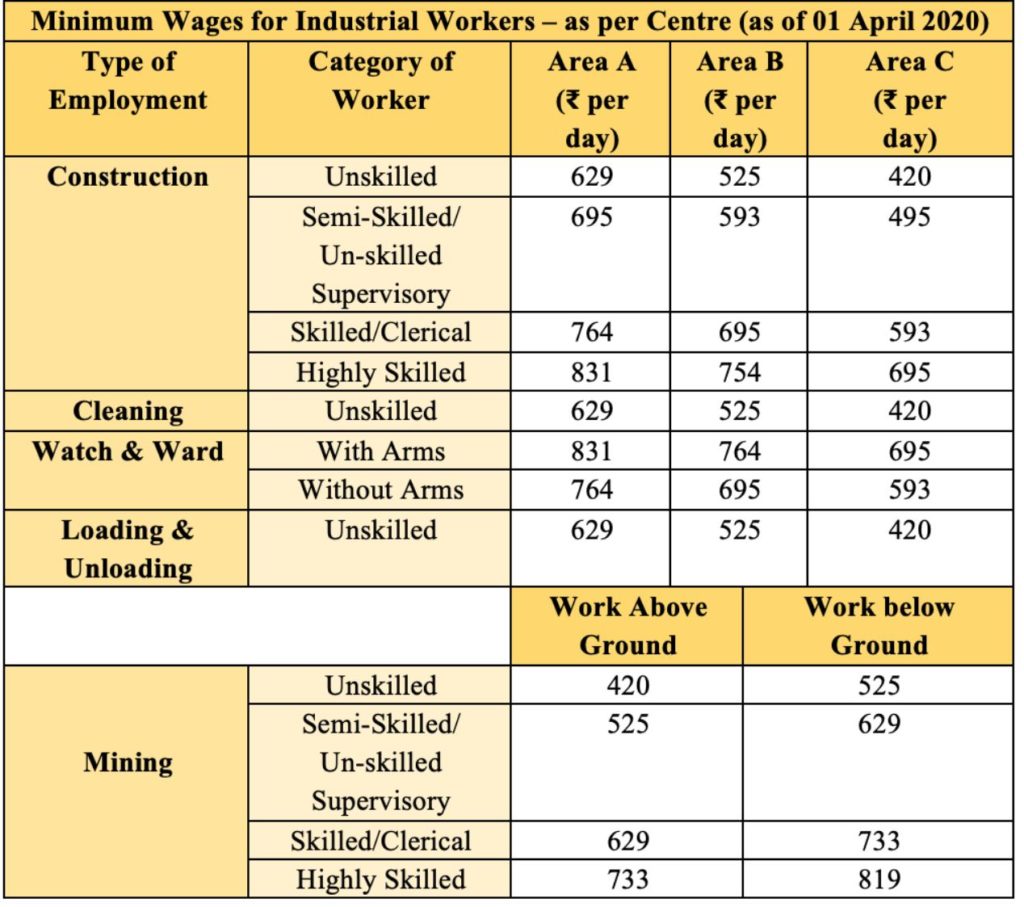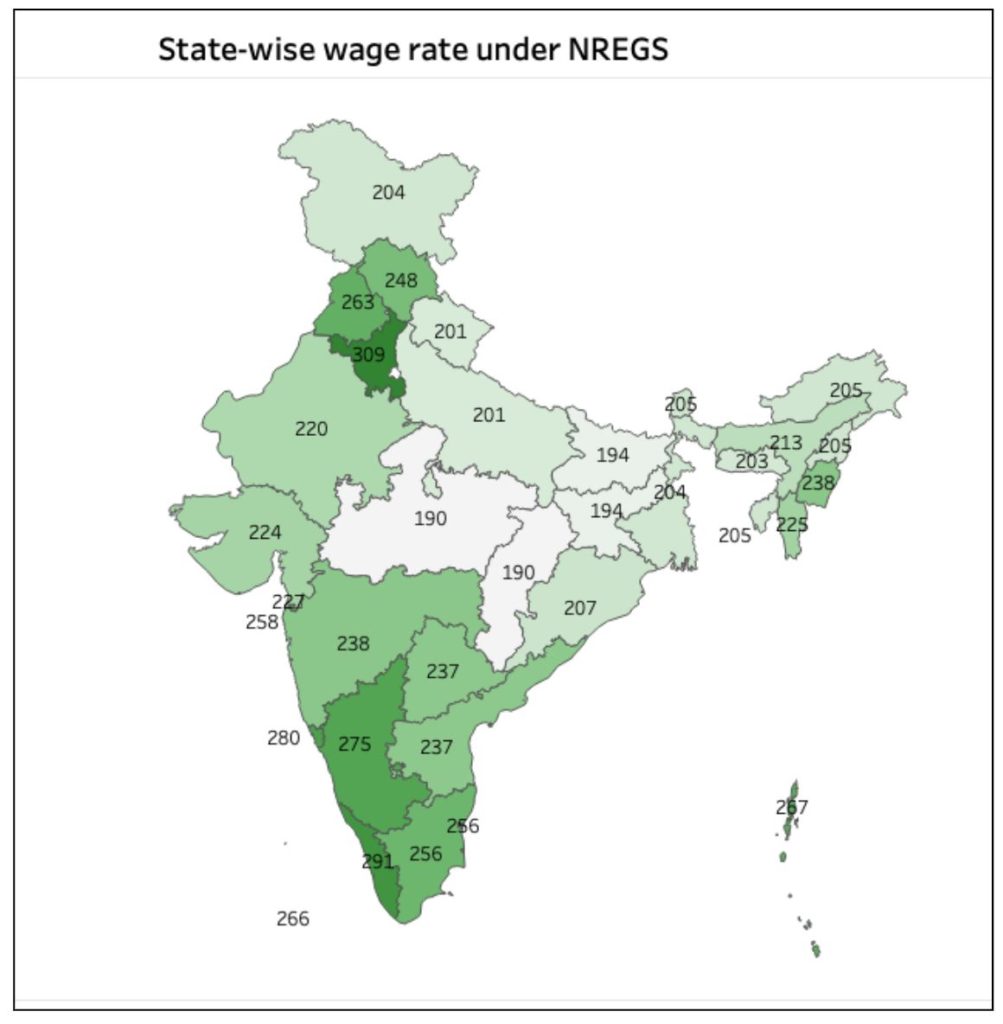The implementation of minimum wages has always been a cause for concern. The tardy implementation is in part a result of the complex system around determining minimum wage with 100s of employment criterion. Here are the details.
In the earlier story, we explored the concept of Minimum Wage in India and the related legislation. The Government of India notified ‘The Code of Wages, 2019’ in August 2019 which replaces a few labour & employment related laws, of which Minimum Wages Act -1948 is one. The purpose of the new act is to regulate wage and bonus payments for all the employees across industry, trades, businesses etc.

One of the key tenets of ‘The Code of Wages, 2019 is ‘Floor Wage’. The Central Government would be fixing a floor wage which takes into consideration the minimum living standards of a worker. The Central government can fix different floor wages for different geographical locations.
Furthermore, the Minimum Wage fixed by the Central and State governments should not be less than the floor rates. The revision of these minimum wages needs to be done at an interval of not more than five years.

In this story, we look at the prevailing minimum wage rates across the country at central and state level. We also explore the difference in the wages across different sectors in states. Labour Welfare & Compensation, being part of the concurrent list, both central & state governments exercise authority in determining the minimum wages in respective sectors and that is the reason for variances in the minimum wages across the country.
Revised VDA has resulted in revision of Minimum wages from 01 April 2020
On 08 May 2020, Central Government has revised the Variable Dearness Allowance (VDA) being paid to the workers, resulting in changes to the Minimum Wage Rates set by Central Government for employment in various sectors. The change in VDA was as a result of increase in the average Consumer Price Index for Industrial workers. It increased to 324 from 310.83 as on 31 December 2019 (Base Index Year 2001).

The resultant increase in Minimum wages was affected for workers employed in Agricultural sector and various industries.
Minimum wages fixed by Centre for employees in Agriculture
The Minimum wage rates fixed by the Centre for those employed in Agricultural sector varies as per the skill of the workers as well as the geographical location. Larger Urban locations like Delhi, Mumbai, Chennai, Kolkata, Hyderabad etc. are categorized under Area A. Comparatively smaller Urban areas fall under Area B and all those not falling under both these areas fall under Area C.
As per the new Minimum Wages which are effective from 01 April 2020, an Unskilled worker employed in Agricultural sector needs to receive a minimum of ₹ 400 if employed in Area A. The wages for Area B and Area C are lower at ₹ 365 and ₹ 362 respectively. The wages for Semi-skilled and Skilled workers are comparatively higher.
A Highly Skilled Worker engaged in Agriculture sector receives ₹ 526 in Area A and ₹ 489 in Area B. However, a large portion of the agricultural workers are employed in Area C geographical location (rural), whose latest minimum wage fixed by the centre is ₹ 438 per day.

Workers employed in different Industrial Sectors
The Centre has fixed varying minimum wages for employment in different types of Industrial Sectors. The broad categories of employment under industrial sector include:
- Workers employed in different types of mining operations
- Workers employed in construction of Roads and Highways, laying of various infrastructure like water, electric, telephones etc.
- Workers employed in Stone Mines
- Workers in Sweeping and Cleaning activities
- Workers in Watch & Ward Services
- Workers employed in Loading and Unloading activities
The Unskilled workers in Mining activities above the ground receive the least minimum wages i.e. ₹ 420 per day. Their minimum wage rates are equal to other Unskilled workers involved in activities – construction, cleaning, loading & unloading and belong to locations under Area C.
The Unskilled workers working below the ground in Mines fare comparatively better at par with other unskilled workers in locations of Area B. Highly skilled workers involved in construction (Area A) and those employed in watch and ward services and possess arms, have the highest wage rates with minimum wage of ₹ 831 per day. Highly Skilled workers in mining activities and working under the ground have the next highest minimum wage rate of ₹ 819 per day.

The workers involved in Stone Mining activities have different criteria for setting minimum wage rates. The rates vary depending on the activity they are involved in and their skills. Few of these workers have among the highest minimum wage rates.
Among the lowest minimum wages is the workers who are involved with excavation of Soft soil, whose minimum wage rate is ₹ 424 per day. The workers involved with removal and stacking of rejected stones receive even less with ₹ 340 per day.
Meanwhile the workers who handle excavation of rocks have minimum wage rate of ₹ 844.
The highest minimum wage rate in the whole of Industrial Sector is received by those employed in Stone breaking and Stone Crushing activities. Among them, the least is those working on stones larger than 5 inches (₹ 1,071 per day), while the highest is the workers who deal with stones of size 1 – 1.5 inches (₹ 2,600 per day).

States have set their own minimum wage rates for different types of Employment
Labour Welfare & Compensation is in the Concurrent List as per the constitution of India. This essentially means that both the Centre and State can enact legislation for Labour related matters, with few reserved for Centre.
The sectors discussed earlier in the story i.e. Agricultural and few of the Industrial related employment are in the purview of the centre. The States can provide a higher minimum for wage for these employments specified by Centre but should not pay less than Centre’s amount.
Apart from these, there are various other types of employment for which the states determine the minimum wage rates. Here is a look at few of these types of employment in different states.
Highly Skilled Employees
A common definition used by the states to categorize highly skilled employees is ‘Job requires high degree of skill, judgement and capacity to supervise’.
Supervisor, Foremen, Shift Supervisor, Technical Supervisor, Senior Mechanic, Computer Programmer, Assistant Engineer, Assistant Production Manager, are few of the employment types that are categorized as Highly Skilled by the States.
The types of employments listed by each of states are quite varied. While most of the states have provided wage listings under the broad category by their proficiency, few of the states like Tamil Nadu have listed wide ranging jobs.
Few states have also used geographical locations and provided minimum wage rates as per the Zones (I-IV). For the sake of this analysis, we have considered the highest wage earned by Highly Skilled workers in the respective states. Where the skill category is not specified, we have considered the jobs from the roles categorized under High Skill.
Among the major states, Delhi has the highest Minimum wage for high-skilled and supervisory jobs with ₹17,508 per month, closely followed by Karnataka, Andhra Pradesh and Assam.
Tamil Nadu and Rajasthan are among the states with lowest minimum wage for high skilled employees.

Apart from the high skilled employment, office related jobs such as Manager, Data Operators, administrative clerks etc. also have higher minimum wage compared to other employments.
Technicians, Operators, Mechanics etc. categorized as Skilled workers
Skilled employment includes those that a worker is capable of handling the work on their own. Technicians, different types of operators, Mechanics, Carpenters, Black Smiths etc. assistant roles like Production Assistant, Field Assistant etc. are categorized as Skilled employment.
As with the trend observed in case of Highly Skilled and Supervisor roles, States like Karnataka, Andhra Pradesh, Delhi etc. are among the ones with higher minimum wage rates.
Delhi has an average of ₹17,000 pm, while Karnataka is around ₹15,000 pm and A.P around ₹13,000 pm. Haryana, Odisha, Punjab etc. have Minimum wages just above ₹10,000 per month. Meanwhile, the minimum wage for a skilled worker in Rajasthan just above ₹6,000 per month.
The employment falling under Semi-skilled category mostly constitute of assistant roles to the Skilled employment jobs. The minimum wages have the same trends across the states.
High disparity among states for unskilled employment
Unskilled workers constitute a major portion of the workforce. Helpers, Attenders, Watchmen, Ayahs, workers engaged in loading & unloading, general workers in shops & establishments, workers in repair shops and a host of other non-technical, non-operating and non-administrative employments are categorized under unskilled unemployment.
Large variance exists in the minimum wage fixed by the states for these workers. The minimum wage rate for unskilled worker in Delhi is ₹ 14,468 per month, which is higher than the minimum wage rate for high-skilled workers in most of the states.
Andhra Pradesh fixed the minimum wage for unskilled workers at ₹ 9,155. Meanwhile, Karnataka has identified various employments under unskilled category and has specified the minimum wage in the range of ₹ 11,000 – ₹ 12,500. There are variances based on zones, with workers in Zone 1 having higher minimum wage compared to other zones. This is similar to the categorization followed by the central government for metro, urban and other areas.
The minimum wages of unskilled workers in Rajasthan is around ₹ 5,500 that is just over 1/3rd of the wage in Delhi. While Meghalaya and Mizoram are more centrally placed among the states, the rest of North eastern states like Nagaland, Sikkim, Tripura & Manipur have lower minimum wage, slightly better than Rajasthan.
Most of the States have higher minimum wages under NREGS compared to Central’s figure
On 26 March 2020, Government of India increased minimum wage under NREGS to ₹ 202 per day, an increase of ₹ 20 as part of the economic relief package announced in wake of lockdown due to COVID-19. However, this increase in minimum NREGS wage by Centre is lower than the NREGS wage amount being paid by most of the states.
As per the notification issued on 23 March 2020, Haryana has the highest wages under NREGS with ₹ 309 per day.
Bihar, Chhattisgarh, Jharkhand, Madhya Pradesh, U.P & Uttarakhand are the states which have a lower NREGS wage than the wage announced by Centre.

(Note: Sikkim has three Districts where the Minimum wage is ₹ 308. In the Union Territory of Andaman & Nicobar Islands, the wage rate for Andaman District is ₹ 257, while for Nicobar district it is ₹ 282).
Complexity around Minimum wage rates resulting in tardy implementation
Various geographical factors and local conditions influence the minimum wage rate. Delhi for example, has a higher cost of living, hence a higher Consumer Price Index (CPI) that results in a higher minimum wage compared to other states. However, the wage rate difference between Delhi and few other states is quite stark. There is huge variance for similar type of employment in different parts of the country. While cost of living and other factors are understandable, such huge difference in minimum wage is a cause for concern.
Furthermore, implementation is another issue. There are over 1000 different employment criterion in states for determining minimum wages. This has created a complex mechanism to interpret and fix the minimum wage of employees, resulting in the workers getting the raw deal in most instances. This only makes the entire system more complex with discretionary in the hands of the bureaucrats. The demand for labour reforms is a result of such complex systems.
The implementation of minimum wage will not improve as long as such complex systems exist.
The need of the day is for simpler criteria with fewer categories in determining the minimum wages that reflect the market wage rates.
Featured Image: Minimum Wage rates


